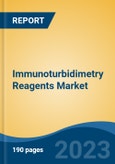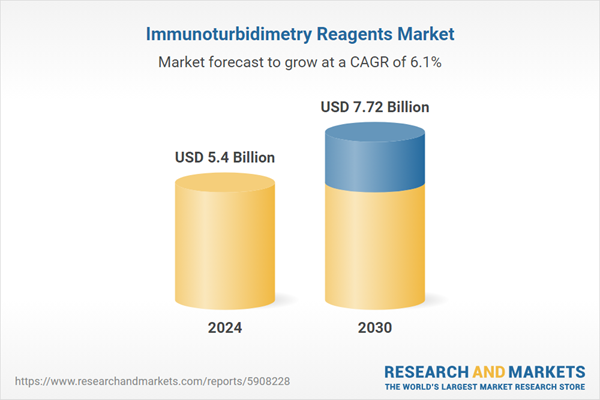Speak directly to the analyst to clarify any post sales queries you may have.
10% Free customizationThis report comes with 10% free customization, enabling you to add data that meets your specific business needs.
The process begins by introducing a patient's serum or plasma sample to a reagent containing antibodies specific to the target protein or analyte. If the target protein is present in the sample, it will bind with the antibodies, forming immune complexes. These complexes scatter light passing through the solution, resulting in an increase in turbidity. This change in turbidity is directly proportional to the concentration of the target analyte. Immunoturbidimetry reagents are crucial components of this process, as they contain the specific antibodies necessary for the formation of immune complexes.
These reagents are meticulously formulated to ensure high specificity and sensitivity, allowing for accurate quantification of the target protein. Moreover, they are designed to minimize interference from other substances in the sample, ensuring precise and reliable results. One of the key advantages of immunoturbidimetry is its wide applicability across a range of analytes, including proteins like C-reactive protein (CRP), immunoglobulins, and complement proteins. This makes it a versatile tool in clinical laboratories for assessing various disease states and monitoring patient health.
Additionally, immunoturbidimetry assays are relatively rapid, providing timely results that are crucial for timely clinical decision-making. Furthermore, immunoturbidimetry is amenable to automation, allowing for high-throughput analysis of patient samples. This enhances the efficiency of clinical laboratories, enabling them to process a large volume of tests in a shorter timeframe. The automation of immunoturbidimetry also reduces the potential for human error, further ensuring the accuracy and reliability of results.
Key Market Drivers
Rising Prevalence of Chronic and Infectious Diseases
The increasing prevalence of chronic and infectious diseases is a significant driver propelling the expansion of the Global Immunoturbidimetry Reagents Market. As healthcare systems worldwide focus on early disease detection, monitoring, and effective management, the demand for high-precision diagnostic solutions such as immunoturbidimetry-based assays continue to rise. Chronic diseases, also known as non-communicable diseases (NCDs), have become the leading cause of mortality and morbidity worldwide.Conditions such as cardiovascular diseases (CVDs), diabetes, kidney diseases, autoimmune disorders, and cancer require continuous monitoring and early detection, creating a strong demand for accurate, reliable, and cost-effective diagnostic reagents like immunoturbidimetry reagents. According to a 2023 report by the World Heart Federation (WHF), global deaths from cardiovascular disease (CVD) surged from 12.1 million in 1990 to 20.5 million in 2021, reflecting a sharp increase in disease prevalence and associated risk factors. CVD remained the leading cause of death worldwide in 2021, with 80% of fatalities concentrated in low- and middle-income countries (LMICs). This trend underscores the urgent need for targeted healthcare investments, improved diagnostic capabilities, and scalable treatment solutions in these high-burden regions.
Biomarkers such as high-sensitivity C-reactive protein (hs-CRP), apolipoproteins (Apo A1 & Apo B), and fibrinogen are crucial for assessing cardiovascular risk and disease progression. Immunoturbidimetry reagents enable fast and cost-effective quantification of these biomarkers in routine clinical settings, increasing their adoption in diagnostic laboratories.
By 2045, projections from the International Diabetes Federation (IDF) indicate that one in eight adults - approximately 783 million people - will be living with diabetes, marking a 46% increase from current levels. Notably, over 90% of cases will be type 2 diabetes, driven by a complex interplay of socioeconomic disparities, shifting demographics, environmental influences, and genetic predisposition. Regular monitoring of glycated hemoglobin (HbA1c) is essential for diabetes management. Immunoturbidimetry assays are widely used for HbA1c testing, offering a high-throughput, automated, and cost-effective solution.
The three most impactful pathogens were those responsible for tuberculosis (TB) at 65.1 million DALYs, malaria at 53.6 million, and HIV/AIDS at 52.1 million, highlighting their significant burden on global health. Notably, malaria parasites had the highest impact among children under five, contributing to 37.2 million DALYs, underscoring the urgent need for targeted interventions, improved access to treatment, and enhanced disease prevention strategies. The pandemic accelerated demand for immune response biomarkers such as ferritin, procalcitonin, D-dimer, and CRP, all of which can be analyzed using immunoturbidimetry reagents.
Hospitals and diagnostic laboratories expanded their immunoturbidimetric testing capacities to monitor COVID-19-related complications, strengthening the market’s growth trajectory. HIV/AIDS and hepatitis patients require frequent monitoring of immunoglobulins and inflammatory markers, both of which are efficiently measured using immunoturbidimetry-based assays. Tuberculosis remains a leading infectious disease, and the demand for serum protein analysis using immunoturbidimetry reagents has risen due to the need for accurate inflammation monitoring. Sepsis is a life-threatening condition requiring immediate detection of inflammatory biomarkers such as CRP, procalcitonin (PCT), and interleukin-6 (IL-6). Immunoturbidimetric tests provide fast and automated screening, enabling early intervention and reducing mortality rates.
Key Market Challenges
Low Adoption Rate of Automated Immunochemistry Products
The low adoption rate of automated immunochemistry products in developing economies presents a significant hindrance to the market's growth and advancement. While automated immunochemistry products offer numerous benefits, including enhanced efficiency, accuracy, and streamlined workflows, their uptake in these regions has been comparatively slow. One primary factor contributing to this challenge is the limited financial resources and budget constraints prevalent in many developing economies. The initial investment required for acquiring and implementing automated immunochemistry systems can be substantial, encompassing the cost of instrumentation, reagents, and the necessary infrastructure.In regions where healthcare budgets are constrained, prioritizing such investments can be a complex decision for healthcare facilities and institutions. Moreover, the maintenance and operational costs associated with automated immunochemistry systems may pose an ongoing financial burden for healthcare providers in these economies. This includes expenses related to instrument calibration, regular maintenance, and staff training. As a result, some healthcare facilities may be hesitant to make the transition from manual or semi-automated methods to fully automated immunochemistry platforms.
Key Market Trends
Rising Adoption of Automated and High-Throughput Diagnostic Systems
Automation is revolutionizing the clinical diagnostics industry, and immunoturbidimetry assays are increasingly being integrated into high-throughput laboratory analyzers. The demand for fast, accurate, and efficient testing solutions is leading to the widespread adoption of fully automated immunoassay platforms, which enhance diagnostic workflows and reduce human error.Automated immunoturbidimetric systems can process a high volume of samples simultaneously, significantly reducing turnaround times and increasing laboratory productivity. Modern analyzers now incorporate artificial intelligence (AI) and machine learning (ML) algorithms to improve result accuracy, error detection, and predictive diagnostics. Automation ensures consistent and standardized immunoturbidimetric assay results, making it ideal for clinical laboratories, hospitals, and reference diagnostic centers. Hospitals and large diagnostic chains are investing in automated immunoturbidimetry analyzers to improve cost efficiency, reduce labor costs, and minimize reagent wastage. The integration of automated immunoturbidimetry systems with cloud-based data management and laboratory information systems (LIS) is expected to drive market growth by enabling seamless data sharing, remote monitoring, and enhanced laboratory efficiency.
Key Market Players
- Danaher Corporation
- Abbott Laboratories Inc
- Siemens Healthineers AG
- F. Hoffmann-La Roche AG
- DIALAB GmbH
- Shanghai Kehua Bio-Engineering Co Ltd
- Randox Laboratories Ltd
- Beijing Leadman Biochemistry Co Ltd
- Fujifilm Corp
- Mindray Medical International Ltd
Report Scope:
In this report, the Global Immunoturbidimetry Reagents Market has been segmented into the following categories, in addition to the industry trends which have also been detailed below:Immunoturbidimetry Reagents Market, By Type:
- Common Immune Turbidimetric Reagent
- Latex Enhanced Immune Turbidimetric Reagent
Immunoturbidimetry Reagents Market, By Application:
- Glycated hemoglobin
- Retinol Binding Protein
- C-Reactive Protein
- Anti-streptococcal hemolysin "O"
- Rheumatoid Factor
- Other
Immunoturbidimetry Reagents Market, By Region:
- North America
- United States
- Canada
- Mexico
- Asia-Pacific
- China
- India
- South Korea
- Australia
- Japan
- Europe
- Germany
- France
- United Kingdom
- Spain
- Italy
- South America
- Brazil
- Argentina
- Colombia
- Middle East & Africa
- South Africa
- Saudi Arabia
- UAE
Competitive Landscape
Company Profiles: Detailed analysis of the major companies present in the Global Immunoturbidimetry Reagents Market.Available Customizations:
With the given market data, the publisher offers customizations according to a company's specific needs. The following customization options are available for the report.Company Information
- Detailed analysis and profiling of additional market players (up to five).
This product will be delivered within 1-3 business days.
Table of Contents
Companies Mentioned
- Danaher Corporation
- Abbott Laboratories Inc
- Siemens Healthineers AG
- F. Hoffmann-La Roche AG
- DIALAB GmbH
- Shanghai Kehua Bio-Engineering Co Ltd
- Randox Laboratories Ltd
- Beijing Leadman Biochemistry Co Ltd
- Fujifilm Corp
- Mindray Medical International Ltd
Table Information
| Report Attribute | Details |
|---|---|
| No. of Pages | 180 |
| Published | February 2025 |
| Forecast Period | 2024 - 2030 |
| Estimated Market Value ( USD | $ 5.4 Billion |
| Forecasted Market Value ( USD | $ 7.72 Billion |
| Compound Annual Growth Rate | 6.1% |
| Regions Covered | Global |
| No. of Companies Mentioned | 10 |









